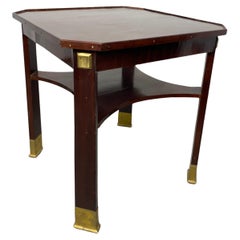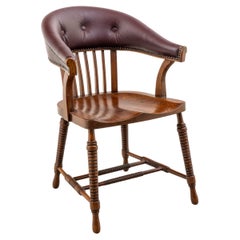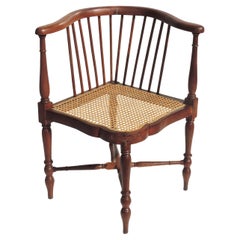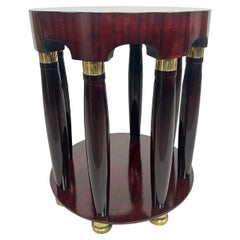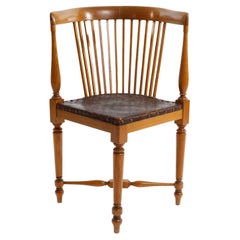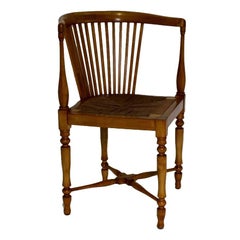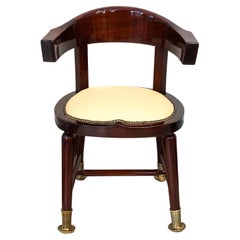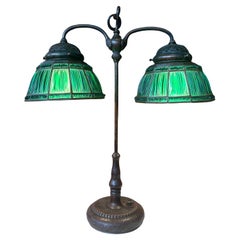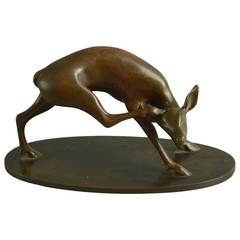O Schmidt
to
2
22
8
29
25
13
3
2
1
1
1
1
13
12
2
2
1
Sort By
Jugendstil coffee table by Adolf Loos for F.O.Schmidt
By Friedrich Otto Schmidt, Adolf Loos
Located in Banská Štiavnica, SK
Jugendstil coffee table by Adolf Loos for F.O.Schmidt in original vintage condition with signs of
Category
Vintage 1910s Austrian Jugendstil Coffee and Cocktail Tables
Materials
Brass
F. O. Schmidt - Adolf Loos - Armchair - Bureau Chair - Leather, Oak
By Adolf Loos
Located in Budapest, HU
Bureau Chair (Armchair)
Vienna, c. 1900, Design by Adolf Loos, Manufactured by F. O. Schmidt, c
Category
Antique Early 1900s Austrian Art Nouveau Armchairs
Materials
Leather, Oak
$3,608
H 35.44 in W 25.6 in D 23.63 in
Adolf Loos F.O. Schmidt 1898-1900 Jugendstil Corner Chair
By Friedrich Otto Schmidt, Adolf Loos
Located in Brescia, IT
Schmidt,
Vienna, Austria, circa 1900.
Very good condition
Seat in excellent condition.
Category
Early 20th Century Austrian Jugendstil Corner Chairs
Materials
Straw, Wood
Very rare Haberfeld secession coffee table by Adolf Loos for F.O. Schmidt
By Friedrich Otto Schmidt, Adolf Loos
Located in Banská Štiavnica, SK
Very rare Haberfeld secession coffee table by Adolf Loos for Fridrich Otto Schmidt. Professionally
Category
Antique Early 1900s Austrian Vienna Secession Coffee and Cocktail Tables
Materials
Brass
$26,464
H 29.53 in Dm 24.02 in
Adolf Loos Corner Chair, F.O. Schmidt, Oak Wood Leather, Jugendstil, 1898-1900
By Adolf Loos, Friedrich Otto Schmidt
Located in Hausmannstätten, AT
A corner armchair designed by Adolf Loos (1870-1933) and manufactured by Friedrich Otto Schmidt
Category
Antique Early 1900s Austrian Jugendstil Corner Chairs
Materials
Leather, Wood
$6,900
H 31.5 in W 20.48 in D 22.45 in
Jugendstil Vintage Maple Tree Adolf Loos Corner Chair or Chair Vienna circa 1900
Located in Vienna, AT
Jugendstil vintage corner chair from maple tree by Adolf Loos and executed by F.O.Schmidt.
A
Category
Early 20th Century Austrian Jugendstil Corner Chairs
Materials
Maple, Rope, Wood
$9,382
H 29.14 in W 18.12 in D 18.12 in
Art Nouveau Armchair 'Model Stössler', Design by Adolf Loos, Vienna, circa 1900
By Adolf Loos, Friedrich Otto Schmidt
Located in Vienna, AT
, Vienna, circa 1900
Model number 6865
The model was produced by the company F. O. Schmidt and was also
Category
Antique Early 1900s Austrian Art Nouveau Armchairs
Materials
Brass
$9,382
H 32.29 in W 22.45 in D 19.69 in
Rare Green Linenfold Double Student Table Lamp Tiffany Studio
By Tiffany Studios
Located in Atlanta, GA
Henry O. Schmidt (1860–1943) patented a new type of mold-cast glass lampshade panels for Tiffany Studios
Category
Early 20th Century American Art Nouveau Table Lamps
Materials
Bronze
Bronze Deer Figure by Jean Rene Gauguin for Nic O Schmidt, Denmark
By Jean Rene Gauguin
Located in New York, NY
.
Impressed "JG" "Nic O Schmidt"
Category
Vintage 1930s Danish Scandinavian Modern More Furniture and Collectibles
Materials
Bronze
F. O. Schmidt / Suite of Furniture à la Loos, Vienna Secession, around 1900
By Friedrich Otto Schmidt
Located in Vienna, AT
, around 1900
BOOKCASE, DESK
mahogany, solid and veneer, brass fittings; locks signed F. O. Schmidt
Category
Early 20th Century Austrian Vienna Secession Living Room Sets
4 x original secessionistic armchair, W. Schmidt for F.O.Schmidt (Vienna, 1908)
By Friedrich Otto Schmidt, Wilhelm Schmidt
Located in Wien, AT
)
Modell-Nummer: -
Ausführung: unbekannte Kunstmöbeltischlerei, verm. F. O. Schmidt oder Prag-Rudniker
Category
Antique Early 1900s Austrian Vienna Secession Armchairs
Materials
Fabric, Oak
$40,899 / set
H 33.08 in W 21.26 in D 19.69 in
Secessionistic Table "Á la Loos", Adolf Loos for F. O. Schmidt (Vienna, 1902)
By Adolf Loos, Friedrich Otto Schmidt
Located in Wien, AT
Objekt: Tisch
Entwurf: Adolf Loos (Wien, 1902)
Modell-Nummer: -
Ausführung: Friedrich Otto Schmidt
Category
Antique Early 1900s Austrian Jugendstil Tables
Materials
Brass
$25,261
H 27.37 in Dm 31.3 in
Jugendstil Armlehnstuhl, Entw: Adolf Loos, verm. Friedrich Otto Schmidt, um 1900
By Adolf Loos, Friedrich Otto Schmidt
Located in Wien, AT
. Spitzer
Modell-Nummer: -
Ausführung: verm. F.O.Schmidt (Wien, um 1900)
Maße in cm (H x B x T x SH x SB x
Category
Antique Early 1900s Austrian Vienna Secession Armchairs
Materials
Brass
$21,652
H 31.7 in W 20.87 in D 22.05 in
4 secessionistic armchairs by Wilhelm Schmidt (Student J. Hoffmann), Vienna 1908
By Wilhelm Schmidt, Friedrich Otto Schmidt, Prag-Rudniker Korbwaren-Fabrication
Located in Wien, AT
)
Modell-Nummer: -
Ausführung: unbekannte Kunstmöbeltischlerei, verm. F. O. Schmidt oder Prag-Rudniker
Category
Antique Early 1900s Austrian Vienna Secession Armchairs
Materials
Fabric, Oak
$40,899 / set
H 33.08 in W 21.26 in D 19.69 in
Adolf Loos for F. O. Schmidt
By Friedrich Otto Schmidt, Adolf Loos
Located in Hanover, MA
firm of Friedrich Otto Schmidt.
Polished black enamel over hardwood and veneer with polished chrome
Category
Antique Early 1900s Austrian Vienna Secession Center Tables
Materials
Chrome
F.O Schmidt Vienna Adams Style Satinwood Paint Decorated Dresser Commode 1910
Located in Long Branch, NJ
F.O Schmidt Vienna Adams Style Satinwood Paint Decorated Dresser Commode 1910
Dimensions : 57
Category
Antique Late 19th Century Austrian Adam Style Commodes and Chests of Dra...
Materials
Wood, Paint
$4,375
H 39.5 in W 57 in D 22 in
Very Rare Fireside Chair by Heinrich Kulka for Adolf Loos
By Adolf Loos
Located in PRAHA 5, CZ
Designed by Heinrich Kulka, Adolf Loos's closest co-worker. Manufactured either by Thonet or F.O
Category
Vintage 1930s Austrian Bauhaus Armchairs
Materials
Leather, Walnut
Rare Linenfold Double Student Table Lamp Tiffany Studio
By Tiffany Studios
Located in Atlanta, GA
original and function well.
From 1913 to 1914, the independent designer Henry O. Schmidt (1860–1943
Category
Early 20th Century American Art Nouveau Table Lamps
Materials
Bronze
Adolf Loos F.O. Schmidt 1898-1900 Jugendstil Corner Chair
By Friedrich Otto Schmidt, Adolf Loos
Located in Brescia, IT
Schmidt,
Vienna, Austria, circa 1900.
Very good condition
Seat in excellent condition.
Category
Early 20th Century Austrian Jugendstil Corner Chairs
Materials
Straw, Wood
Adolf Loos Corner Chairs, F.O. Schmidt, Velvet Wood, Jugendstil, 1898-1900, Pair
By Adolf Loos, Friedrich Otto Schmidt
Located in Hausmannstätten, AT
Friedrich Otto Schmidt, Vienna, Austria, circa 1900.
The condition is very good. The chairs have been
Category
Antique Early 1900s Austrian Jugendstil Corner Chairs
Materials
Wood, Velvet
$17,000
H 29.93 in W 22.45 in D 22.45 in
Adolf Loos Six-Legged 'Haberfeld' Table, F.O. Schmidt, Brass Wood, Austria, 1899
By Adolf Loos, Friedrich Otto Schmidt
Located in Hausmannstätten, AT
Schmidt, Vienna, in 1900s.
It is made of walnut stained wood with brass shoes and a brass surrounded top
Category
Antique Early 1900s Austrian Art Deco Side Tables
Materials
Brass
$29,000
H 26.78 in Dm 31.5 in
Wonderful Austrian Sofa Attributed to Adolf Loos
By Adolf Loos
Located in Munich, DE
Good condition with little sign of use. Presumably made by F.O. Schmidt/ Vienna.
Category
Antique Early 1900s Austrian Vienna Secession Sofas
Materials
Fabric
Large Palshus Ceramic Bowl Ø 27 cm with Midnight Blue Glaze Danish Modern, 1960s
By Palshus, Per Linnemann-Schmidt
Located in Silkeborg, Silkeborg
Large and tall ceramic bowl by Per Linnemann-Schmidt for Palshus Denmark in the 1960s.
The bowl is
Category
Vintage 1960s Danish Scandinavian Modern Decorative Bowls
Materials
Ceramic
$1,196
H 5.12 in Dm 10.63 in
A Massive Pair of Danish Bronze Candlesticks, Now Lamps by NIC O Schmidt
By Nic O. Schmidt
Located in New York, NY
throughout. The lamps can easily be returned to candlesticks. Marked: N I C O. Schmidt Bronze Støber
Category
20th Century Danish Art Deco Table Lamps
Materials
Bronze
F. O. Schmidt / Miksa Schmidt / Exceptionally Desk, 2 Chairs / Vienna, ar. 1900
By Friedrich Otto Schmidt, Miksa Schmidt
Located in Vienna, AT
designed and executed by:
chairs: Friedrich Otto Schmidt, Vienna, around 1900
desk: Miksa Schmidt
Category
Early 20th Century Austrian Jugendstil Desks and Writing Tables
Materials
Brass
$57,740
H 31.5 in D 35.44 in
Adolf Loos / F. O. Schmidt / Large Oval "Haberfeld" Table / Vienna / after 1902
By Friedrich Otto Schmidt, Adolf Loos
Located in Vienna, AT
ADOLF LOOS
FRIEDRICH OTTO SCHMIDT
designed by: Adolf Loos
executed by: Friedrich Otto Schmidt
Category
Early 20th Century Austrian Jugendstil Side Tables
Materials
Brass
$33,682
H 27.56 in D 31.5 in
Adolf Loos / F. O. Schmidt / Large Oval Haberfeld Table, Vienna, after 1902
Located in Vienna, AT
ADOLF LOOS
FRIEDRICH OTTO SCHMIDT
LARGE OVAL TABLE
designed by: Adolf Loos
executed by
Category
Early 20th Century Austrian Vienna Secession Center Tables
Materials
Brass
$30,073
H 27.56 in W 47.25 in D 34.26 in
Adolf Loos attr., Friedrich Otto Schmidt, Chandelier, Vienna Secession
By Adolf Loos, Friedrich Otto Schmidt
Located in Vienna, AT
94.5 cm, W 25 cm, D 25 cm
The archives of F. O. Schmidt & Co. have a photograph of a very similar
Category
Early 20th Century Austrian Vienna Secession Chandeliers and Pendants
$6,014
H 37.41 in W 9.85 in D 9.85 in
" Elephant trunk" table by Adolf Loos
Located in New York, NY
Loos, produced by F. O. Schmidt, c. 1902.
Category
Early 20th Century Austrian Tables
Materials
Marble, Copper
Group of Five Early 1900s California Bay Area Silverplate Cycling Trophies
Located in San Francisco, CA
; O. Schmidt; C. Taggert”
Mark: “Superior Silver Co. / Quadruple / 4021”
Dimensions: H 11.88 in. x W
Category
Antique Early 1900s American Sporting Art Sports Equipment and Memorabilia
Materials
Metal, Silver Plate, Brass
$1,075
H 11.88 in W 8.25 in D 5 in
Get Updated with New Arrivals
Save "O Schmidt", and we’ll notify you when there are new listings in this category.
O Schmidt For Sale on 1stDibs
Choose from an assortment of styles, material and more with respect to the o schmidt you’re looking for at 1stDibs. Each o schmidt for sale was constructed with extraordinary care, often using ceramic, metal and wood. Find 535 options for an antique or vintage o schmidt now, or shop our selection of 16 modern versions for a more contemporary example of this long-cherished piece. Your living room may not be complete without a o schmidt — find older editions for sale from the 18th Century and newer versions made as recently as the 21st Century. Each o schmidt bearing Mid-Century Modern, Scandinavian Modern or Art Nouveau hallmarks is very popular. You’ll likely find more than one o schmidt that is appealing in its simplicity, but Per Linnemann-Schmidt, Palshus and Eugen Schmidt produced versions that are worth a look.
How Much is a O Schmidt?
Prices for a o schmidt can differ depending upon size, time period and other attributes — at 1stDibs, they begin at $1 and can go as high as $350,000, while the average can fetch as much as $2,349.
